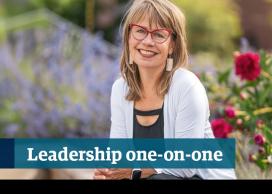Karen Carriero (Kcee) is the Associate Vice-President, Communications. She is responsible for developing an over-arching long-term communications strategy for UBC, ensuring alignment with the university’s vision, mission and values. She oversees the Public Affairs, Brand and Marketing and Internal Communications units within the External Relations portfolio.
Originally from Australia, Kcee brings with her a wealth of experience in communications, having served in senior leadership positions at a number of large organizations, including Curtin University of Technology and most recently, the University of Western Australia.
Q1. What quality do you most admire in a leader?
KC: I admire integrity and authenticity… Authentic leaders who can have the inspiring conversations as well as the tough discussions. They will often roll up their sleeves and pitch in to help build their vision. I also admire leaders who are able to try something new, prepared to not always get it right, and be willing to try again.
Q2. What makes you laugh?
KC: I’m a sucker for stand-up comedy… I like Billy Connolly, the Australian comedian Charlie Pickering and the Irish comedian, Jimeoin. I think it’s great how stand-up comics bring the mundane to the stage and put a different perspective on it.
Q3. Who inspires you, and why?
KC: I am inspired by my ancestors who immigrated to Australia. My father was one of six children with an Irish mother and a Sicilian father. They immigrated there for a better life, but were ostracized during the war years, because my grandfather was incorrectly taken away and interned at a war camp after his identity was mixed up with another Sicilian who supported Mussolini. So, when I think of who inspires me, it’s the people who are brave enough to do something really scary, or build something new for their family despite the adversity that faces them.
Q. If you could have a super power, what would it be?
KC: To fly, for the perspective it would give me on the world.
Q5. What’s the most important lesson you’ve learned?
KC: A previous boss once told me: “Remember rule number six”. I had never heard this before, and had no idea what it meant. I looked it up… The rule is, ‘don’t take yourself so damn seriously’. Of course, the statement begs the question, what are the other rules? There are no other rules!
This idea comes from a story in the book, The Art of Possibility by Benjamin Zander. I think it’s a clever story.
If you want to be that authentic leader, to really have integrity, you must remember rule number six. Take seriously what you do, but if you take yourself too seriously, your perspective gets warped, making it hard to be an authentic leader.
Q6. What was your favourite song as a teenager?
KC: There is one song in particular that stands out for me, called “Eagle Rock” by Daddy Cool. It was a rock anthem in Australia when I was a teenager.
Q7. How do you like to recharge?
KC: I love to be outside. The ocean in particular — its powerful energy — both calms and energizes me. I also like walking my dog, Lulu, and going to the gym.
Q8. For you, what makes UBC different?
KC: It’s hard to know, so early on in my time here. But I’m on a quest to find out.
One thing I have noticed during my short time here is that, despite being a relatively old university, UBC feels young. I think that’s a result of its meteoric rise that’s happened over the years, through a concerted effort and sheer hard work. I really like that about UBC. There’s tenacity here. We’re pushing the boundaries in everything we do.
Q9. What is the best advice you were ever given?
KC: My dad taught me to always invest in others and to treat others as you want to be treated.
Q 10. What do you value in your colleagues?
KC: I value colleagues who are creative and don’t revert to how things have always been done; who are willing to take a chance; who I can riff off of to build something better; colleagues who have energy, drive and focus and are not looking to conform to the rules, but make new rules… That’s one of the addictive things about working at a university — there are lots of people like that!
Q11. What would you like to be remembered for?
KC: I’d like to be remembered for the investments I’ve made in others.
Q12. What do you think the role of communications is in higher education institutions?
KC: Communications is about connections. We form a conduit that connects the work we do to the outside world, and magnetizes people from the outside to the institution.
Being a professional communicator in higher education can sometimes be a tough gig. It’s only in recent years that this professional practice has been integrated into our more traditional institutions. Higher education institutions need to get serious about amplifying the great work they’re doing. Some people have the perception that communications exists to spin the yarn. When in fact, we’re here to understand and promote the very fiber and the true being of the university.
Q13. What are your priorities for the year ahead?
KC: My first priority is developing the overarching strategic communications framework for the university. My plan is to pull this together in collaboration with communicators across the campus. Together, we need to build a framework, collectively agree on some principles, and then fill the rest out as we go.
I’m also focused on building a sense of team, not just within the Communications portfolio, but amongst the broader network of communicators.
And finally, I’ll be focused on trying to get to the heart of what it is in UBC that is different from any other university in the world. I am excited to learn more about UBC, my new colleagues and to discover more about what makes us distinctive.
Published: September 14, 2017
Interviewed by: Megan Czerpak, UBC Internal Communications



